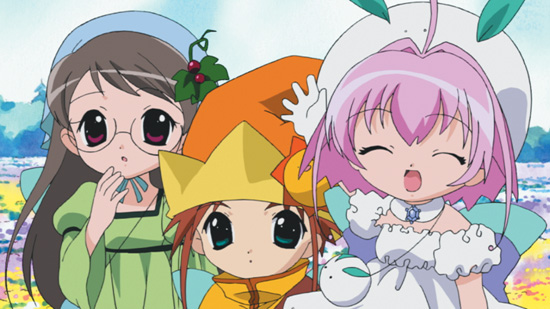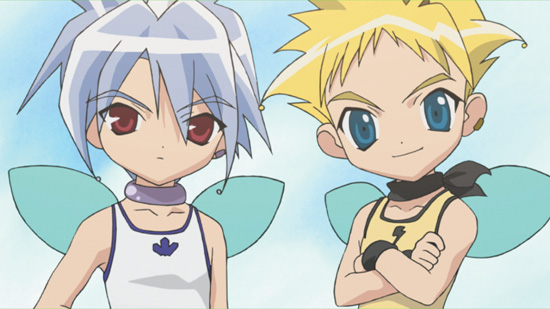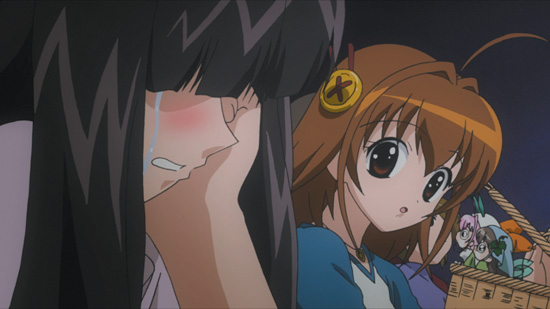
In A Little Snow Fairy Sugar, Saga is a hyper-competent, hyper-organized girl who lives with her grandmother in the (fictional) walled town of Muhlenberg, Germany. Between school, a part time job at the “Little Me” coffee shop, and visits to the local music store to practice playing her late mother’s piano, Saga’s life is neat, tidy, and entirely ordinary. All of this goes out the window when Saga takes shelter from the rain in an alleyway on her way home one day.
There she encounters a strange creature resembling a tiny person in an outlandish outfit. When Saga offers the hungry sprite a waffle, she inadvertently makes friends with Sugar, an apprentice Season Fairy. It turns out that all of the meteorological phenomena that define the seasons—snow, wind, rain, and even sunshine—are controlled by these enigmatic beings from the fairy realm, who are normally invisible to humans. But for some unknown reason, Saga can perceive Season Fairies, and soon she finds herself with a hyperactive, diminutive roommate in the form of Sugar.

The central premise of the series is that in order to become full-fledged Season Fairies, apprentices like Sugar (and her friends, Salt and Pepper) must first journey to the human world. To continue their studies, they must discover the secret of the “Twinkle” in order to make a magical flower bloom. As the series progresses, Sugar—in a clueless and disruptive fashion—searches for the “Twinkle” and drives Saga crazy in the process. A Little Snow Fairy Sugar is full of everyday adventures.
More Season Fairies appear, including a bumbling Elder and a pair of mischievous delinquents who control thunder and ice. There are wacky hijinks involving Greta, a poor little rich girl who views Saga as her primary rival, and there are half-baked experiments with Phil, a boy in Saga’s class whose impractical inventions invariably break down in a burst of cartoon smoke. There’s a story arc involving a traveling troupe of performers staging a fairy tale play, one of whom may or may not also be able to perceive Season Fairies. It’s all very innocent and low-key, but aside from being a cartoon aimed at children, A Little Snow Fairy Sugar also functions on another level.

A Little Snow Fairy Sugar is a cute, peppy, and upbeat series, but the show is undergirded with some somber themes. Beneath its glossy veneer, A Little Snow Fairy Sugar is ultimately a story about life, loss, and the painful parts of growing up that involve letting go of the friends and family we inevitably leave behind. Although it’s never explicitly stated, it’s heavily implied that the reason Saga can see fairies in the first place stems from a near-tragic accident in her childhood, and the memory of Saga’s deceased mother looms large in the forefront of Saga’s mind.
Even the lyrics to “Sugar Baby Love,” the show’s seemingly cheery opening theme and a reinterpretation of a 1974 bubblegum pop song by The Rubettes, overtly reference the difficulty Saga faces in coming to grips with the process of mourning: every week, she leaves flowers and a letter at her mother’s piano, a stand-in for a gravestone. When Sugar finally discovers the secret to making the magic flower bloom, there’s a touching scene where the little snow fairy tries to hold the petals closed. She doesn’t want to return to the fairy realm because it means saying goodbye forever to her human friend.

Originally released on DVD in North America by Geneon Entertainment, Sentai Filmworks has rescued the license for A Little Snow Fairy Sugar and is releasing it under their Sentai Selects label. I highly recommend the show. Although the animation by J.C. Staff employs some digital camerawork that hasn’t aged well, the character designs by Koge-Donbo are as fresh today as they were some 15 years ago when the series ran on the Tokyo Broadcasting System. The story of Sugar and Saga is bittersweet, and the themes that the series explores are timeless.
studio/company:
Sentai Filmworks
available:
Now
rating:
TV-PG

